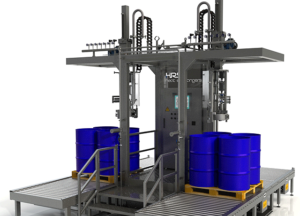Aseptic Filling Fundamentals

One of the things needed to produce a pasteurised product with a long life which can be distributed at ambient temperature is aseptic packaging. This technology differs from conventional canning techniques in that the containers are pre-sterilised and then filled with cold product in a cold environment in commercially sterile conditions, before being closed in a totally sterile environment.
Aseptic packaging uses filling systems operating in sterile conditions in hermetically sealed machines equipped with sterilisation systems for the packaging prior to filing. These often use hydrogen peroxide distributed by means of a current of warm air, thus creating a bacteria free atmosphere in the filling section.
Before packing, an aseptic conditioning is carried out which consists of disinfecting all components used in the conditioning, cleaning and sterilisation stages aimed at reducing the initial contamination.
Benefits of Aseptic Packaging
The efficiency of the thermal treatments during the aseptic process means there is no deterioration in product flavour or nutrition. This results in a higher quality product than obtained with traditional thermal processes. Other advantages include:
- Chemical preservatives are not necessary
- Lower transport costs than IQF or Individual Quick Freezing
- Decrease storage costs
Aseptic Containers
Special attention must be paid to the packaging used. The packaging in aseptic packing systems plays a very important role because, if it cannot be hermetically sealed to provide an effective barrier to oxygen and to light, the sterilisation achieved in the preparation stages will be lost.
Various forms of aseptic packages, commonly called aseptic bags, are currently available on the market. These comprise the bag itself, together with a filling nozzle, a cap and an outer container. The most commonly available sizes of bags are 5, 10, 20 and 200 kg although the weights will vary with the specific density of the product contained.
The barrier material in these bags is normally vacuum metallised polyester or vinyl ethyl alcohol while the body of the bag is normally low or medium density polyethylene.
Applications
The HRS Aseptic Filler is ideally suited to satisfy the requirements of different markets:
- Catering applications
- Low acid products. Vegetables (spinach leaves, whole peas, strips of peppers, diced onion), precooked meals, etc.
- Whole and diced fruit (peach, apricot, strawberry, pear, apple, tropical fruits), pulps, purees and fruit concentrate
- Fruit preparations
- Diced tomatoes and tomato concentrates
HRS Heat Exchangers designs and manufactures Bag-in-Drum and Bag-in-Box type Aseptic Fillers. Fillers with double heads are available for aseptic packaging with filling nozzles of 1 or 2 inches according to the type of product being packaged. This type of filler uses preformed, pre-sterilised bags with a cap of 1 or 2 inches in different forms:
- Bags from 5 to 200 litres
- Linked bags from 5 to 20 litres